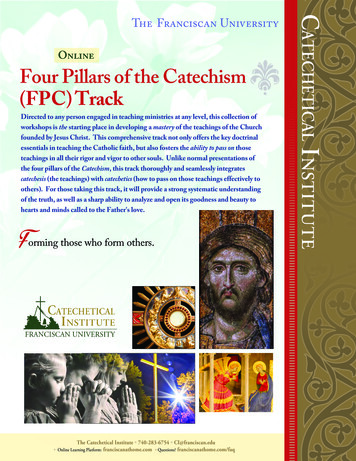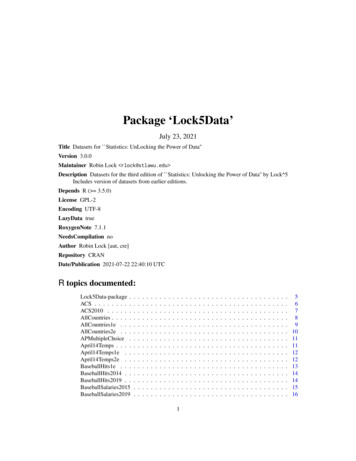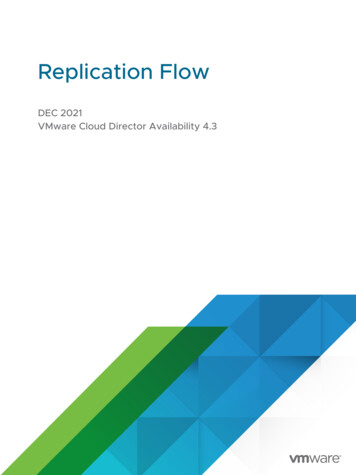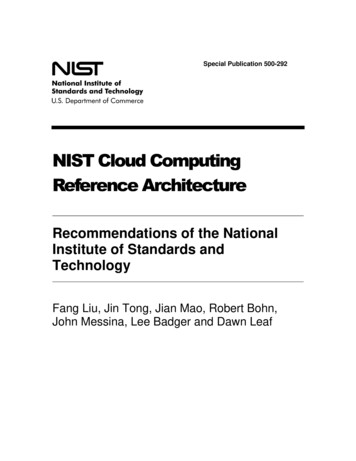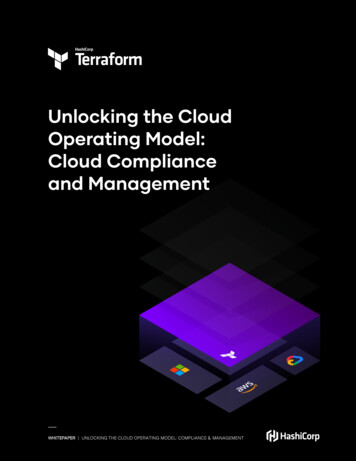
Transcription
Unlocking the CloudOperating Model:Cloud Complianceand ManagementWHITEPAPER UNLOCKING THE CLOUD OPERATING MODEL: COMPLIANCE & MANAGEMENT
ContentsOverview03Implications of the Cloud Operating Model04Cloud Operating Model: Provision05Cloud Operating Model: Compliance & Management07Terraform Enterprise08Workflow Integrations10ConclusionWHITEPAPER UNLOCKING THE CLOUD OPERATING MODEL: CLOUD COMPLIANCE AND MANAGEMENT122
OverviewCloud adoption is a secular trend. Organizations undergoing a digital transformation ultimatelyput pressure on teams delivering and supporting software applications. Digital experiencesare the primary interface between customers and businesses; even businesses selling to otherbusinesses. Modern digital interactions are responsively designed and built cloud-first to providerich, personalized experiences informed by large scale data processing and intelligence as quicklyas possible. This pattern of prioritizing digital interactions forces a change in the model for softwaredelivery and is felt most by IT, with a strong dependency on that team to build an organization-wideoperating model for delivering cloud based applications.TRADITIONAL DATACENTERMODERN DATACENTER“STATIC”“DYNAMIC”DEDICATED INFRASTRUCTUREPRIVATE CLOUDSYSTEMS OF RECORDAWSAZUREGCPSYSTEMS OF ENGAGEMENTWHITEPAPER UNLOCKING THE CLOUD OPERATING MODEL: CLOUD COMPLIANCE AND MANAGEMENT3
Implications of the Cloud Operating ModelThe essential implication of the transition to cloud is the operating model to accommodate the shiftfrom “static” infrastructure to “dynamic” infrastructure. The challenges IT teams are addressing withthe Cloud Operating Model are:1.Volume and distribution of services2.Ephemerality and immutability3.Deploying to multiple target environmentsThe impact of these changes is that IT teams will need to adjust their approaches for each of the fourlayers of operation:STATICDYNAMICRunDedicated InfrastructureScheduled across the fleetConnectHost-basedDynamic IPService-basedDynamic IPSecureHigh trustIP-basedLow trustIdentity-basedProvisionDedicated serversHomogeneousCapacity on-demandHeterogeneousWHITEPAPER UNLOCKING THE CLOUD OPERATING MODEL: CLOUD COMPLIANCE AND MANAGEMENT4
Cloud Operating Model: ProvisionA common starting point for the Cloud Operating Model is to enable the operations team to shift theirfocus away from provisioning only dedicated servers based on homogenous sets of infrastructureto workflows that enable shift left IT with capacity on-demand from a variety of Cloud (and service)providers.To address the core tenets affecting provisioning (volume and distribution of services, ephemeralityand immutability, and deploying to multiple target environments), organizations are moving to anautomation based operating model for cloud infrastructure.HashiCorp TerraformHashiCorp Terraform provides the foundation for cloud and on-premises infrastructure automationusing infrastructure as code for provisioning and compliance in the cloud operating model.BEFORE TERRAFORMOKAPPLICATIONSTEAMINFRASTRUCTUREREQUESTIT REAFTER TERRAFORMAPPLICATIONSTEAMTFETF TEMPLATETF CLIPOLICYGOVERNANCEINFRASTRUCTUREWHITEPAPER UNLOCKING THE CLOUD OPERATING MODEL: CLOUD COMPLIANCE AND MANAGEMENT5
Reproducible infrastructure as codeTerraform automates through an infrastructure as code approach to provisioning cloud infrastructureand services. Users define a desired topology of infrastructure and services in a configuration file usingversion control. Terraform translates those configuration files into appropriate API calls to end providersautomating resource provisioning to reduce human error and failed builds. Open source providers allowrapid creation and support for any infrastructure.WHITEPAPER UNLOCKING THE CLOUD OPERATING MODEL: CLOUD COMPLIANCE AND MANAGEMENT6
Cloud Operating Model: Compliance & ManagementThe infrastructure as code approach to cloud infrastructure automation enables organizations toextend Terraform for provisioning and management in the cloud operating model and reduces therisks organizations are faced with as they grow their footprint in the cloud. However, the lack of ITgovernance in the distributed operating model increases risks for security, regulatory compliance, andoperational consistency.Security Posture. How to create and enforce policies to prevent breaches? Example security concernsinclude: Restrict app versions with vulnerabilities Restrict resources with a public IP address Prevent security groups with egress 0.0.0.0 Restrict use to only approved modulesRegulatory Compliance. How to create and enforce policies to prevent regulatory noncompliance?Example of regulatory compliance concerns include : GDPR regulations FedRamp regulations HIPAA regulations PCI standardsOperational Consistency. How to create and enforce policies to ensure operation consistency tomanage costs? Examples of operational concerns include: Ensure infrastructure follows organization-based best practices Manage and control cloud and service expenditure and growthTraditional approaches to preventing these types of things of infractions from occurring are anchoredin the idea the IT is the gatekeeper to infrastructure. Policy isn’t codified, but rather known triballywithin the IT team. If policy is enforced, then it’s enforced manually by that gatekeeping organization—this approach stymies the speed and developer self-service benefits cloud infrastructure offersorganizations. Some teams will automate policy enforcement, but will do so through scans that occurafter the infrastructure is provisioned opening up opportunities for risk while the out-of-complianceinfrastructure exists before it’s scanned. Finally, we see organizations that take a least commondenominator approach to enforcement assuming that all infrastructure is only susceptible to certainrisks and checking against those— leaving open unique vectors for bespoke parts of the organizationsinfrastructure topology.WHITEPAPER UNLOCKING THE CLOUD OPERATING MODEL: CLOUD COMPLIANCE AND MANAGEMENT7
Terraform EnterpriseTerraform Enterprise provides the foundation for cloud infrastructure automation with infrastructureand policy as code for compliance and management in the cloud operating model. Organizationsadopting the cloud operating model look for high agility and high control as they rapidly bringproducts to markets and internal customers. They seek a desired state of: Consistent, technology agnostic workflows Automation for infrastructure and service provisioning Security posture aligned to the speed and surface area of automationTo achieve that desired state organizations need to: Enable real-time control and proactive policy enforcement Eliminate manual processes and bottlenecks Centralize management and control across technologiesCloud Compliance and ManagementTerraform Enterprise addresses cloud compliance and management with an automation platform thatenforces policies within the provisioning workflow to reduce risk through proactive policy enforcement,manage costs, and increase productivity through automation.Sentinel Policy as Code. Using Terraform Enterprise, policy owners (security, compliance, audit, finance,operations) use Sentinel policy as code to define policies. Sentinel policies are then enforced againsteach Terraform plan prior to executing the provisioning. Because Sentinel offers preventative, proactivepolicy organizations can confidently instill best practices for production workloads that maintaincompliance with necessary regulations.WHITEPAPER UNLOCKING THE CLOUD OPERATING MODEL: CLOUD COMPLIANCE AND MANAGEMENT8
Sentinel Policies can be enforced across a range levels from Advisory, which warns when a policybreaks, but doesn’t prevent it from being provisioned, to Soft Mandatory, which requires an override tobreak policy, or Hard Mandatory, which prevents provisioning if a policy breaks.Automated Policy Enforcement. Terraform enforces Sentinel policies on workspaces before itprovisions them, meaning that once an organization defines a guardrail in Sentinel no infrastructurecan be provisioned that breaks it— enforcement is automatic.More information about writing and testing Sentinel policies can be found in the Sentinel Guide as wellas a repository of example policies.Cost Estimation. Cloud infrastructure provides compelling pay-as-you go pricing. When provisioninginfrastructure it is challenging to understand the cost implications of new or changed infrastructurebefore it is applied. Most organizations rely on after-the-fact alerts from their cloud provider, usingdedicated third party services that continually monitor changes in cost, or potentially waiting until theyreceive their end of month bill to understand the cost impact of their changes. Terraform provides acost estimation capability that programmatic estimates cost for new cloud deployments or changes toexisting ones, before applying those changes or actually incurring costs.Cost Management via Policy Enforcement. Sentinel allows cost-centric policies to be created andthen automatically enforced in the Terraform workflow. Administrators then have the ability to approvesignificant changes or to completely prevent specific workspaces from exceeding predeterminedthresholds. For example, administrators could write policies that prevent large, expensive machinesfrom being provisioned unnecessarily, or enforce overall budget restrictions for a teams’ deploymentswithout prescribing what machines to use. Even further, policies can be dynamically written such thata certain threshold of change is allowed month over month, but nothing exceeding a certain dollarlimit.Audit logging. Terraform Enterprise offers rich audit logging for organizations that need insight intothe resources managed by terraform. Audit logs emit information whenever any resource managedby Terraform Enterprise is changed, so teams can understand who made changes and what changeswere made. Many organizations leverage audit logging to achieve and ensure regulatory compliance.WHITEPAPER UNLOCKING THE CLOUD OPERATING MODEL: CLOUD COMPLIANCE AND MANAGEMENT9
Workflow IntegrationsMany customers leverage the cloud management features of Terraform from within an pre-existingworkflow or tool chain. Terraform enables this through integrations with major VCS, CI/CD, and servicemanagement tooling as well as supporting a full REST API. These integrations allow organizations to driveoperational consistency without impacting productivity.WORKFLOW PARTNERSPROVIDERSINFRASTRUCTURE PARTNERSVersion Control Systems (VCS)Terraform users define infrastructure in a simple, human-readable configuration language called HCL(HashiCorp Configuration Language). Users can write unique HCL configuration files or borrow existingtemplates from the public module registry. Most users will store these configuration files in a versioncontrol system (VCS) repository and connect that repository to a Terraform workspace. With thatconnection in place, users can borrow best practices from software engineering to version and iterate oninfrastructure as code, using VCS and Terraform Cloud as a delivery pipeline for infrastructure. Terraformhas integrations with Azure DevOps, BitBucket, Github, and Gitlab.WHITEPAPER UNLOCKING THE CLOUD OPERATING MODEL: CLOUD COMPLIANCE AND MANAGEMENT10
When you push changes to a connected VCS repository, Terraform will automatically trigger a plan inany workspace connected to that repository. This plan can be reviewed for safety and accuracy in theTerraform UI, then it can be applied to provision the specified infrastructure.Continuous Integration, Continuous Delivery (CI/CD) PipelineTerraform can be called from within most CI/CD pipelines such as Jenkins, Circle, Travis, and Gitlab. Manyusers leverage the programmability of Terraform to automate as much of their provisioning workflow aspossible, while enforcing guardrails through policy as code. Terraform’s API-driven run provides flexibleprovisioning workflows using an infrastructure as code approach that any organization can manage. Acontinuous integration (CI) system monitors changes in Terraform code and drives provisioning usingTerraform Cloud’s REST API. This approach allows organizations to implement a range of actions in theirCI pipeline as part of an infrastructure provisioning workflow and still benefit from Terraform Cloud’scapabilities such as private modules, state management, policy as code (Sentinel) and more.IT Service Management (ITSM)Terraform Enterprise also includes a first class ServiceNow integration. ServiceNow provides digitalworkflow management, helping teams work quickly and efficiently with one another by offering astraightforward workflow for their interactions. The ServiceNow Service Catalog offers a storefront ofservices that can be ordered by different people in the organization. One common request between teamsis for Cloud resources: a developer needs a fleet of machines to test out a codebase or the IT team infinance has a request for infrastructure to run their new accounting software. For organizations who use theServiceNow Service Catalog, the requests can be submitted through ServiceNow and routed to the rightteam for Cloud Infrastructure. Terraform Enterprise provides provisioning automation through infrastructureas code and security, compliance, and cost-sensitive policy enforcement against all resources as they areprovisioned.Our newest integration connects the human workflow power of ServiceNow with the infrastructureworkflow capabilities of Terraform Enterprise. This enables teams that are not code-centric to safelyadopt best-in-class provisioning workflows and tooling, while still getting developing competency withinfrastructure as code.WHITEPAPER UNLOCKING THE CLOUD OPERATING MODEL: CLOUD COMPLIANCE AND MANAGEMENT11
ConclusionAs organizations begin to adopt the cloud operating model, they first face the challenge of provisioningcloud infrastructure. Many organizations believe that even if the cloud unlocks new speed, it also opensup new security risks, which can only be solved through processes that reduce that unlocked speed.However, Terraform offers a powerful alternative to that legacy model by combining an infrastructureas code approach to provisioning with a policy as code approach to compliance and management.This enables organizations to have both high agility and high control as they develop competencyin infrastructure provisioning, compliance and management. This paper provides an overview ofhow organizations can leverage Terraform Enterprise to implement multi-cloud compliance andmanagement ensuring effective, unencumbered adoption of the cloud operating model.WHITEPAPER UNLOCKING THE CLOUD OPERATING MODEL: CLOUD COMPLIANCE AND MANAGEMENT12
Implications of the Cloud Operating Model The essential implication of the transition to cloud is the operating model to accommodate the shift from "static" infrastructure to "dynamic" infrastructure. The challenges IT teams are addressing with the Cloud Operating Model are: 1. Volume and distribution of services 2. Ephemerality and .



